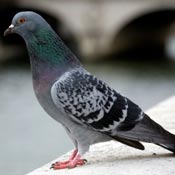Pigeons: carriers of diseases and causing structural corrosion

Feral Town Pigeon
The feral pigeon (Columba livia) are descendants from domesticated pigeons which have return to the wild. The domesticated pigeon in turn was originally bred from wild rock doves. Cities and towns mimic their ancestral “rock cliff” environment ideally. An abundance of food and shelter present means that original escapees have multiplied exponentially and become serious urban pests.
Pigeon droppings not only pose a serious health risk (i.e. they contain salmonella sp. listeria sp, campylobacter sp and fungal spores amongst others), but they also corrode metal, mortar, lime stone, and even damage paint caused by uric acid present. A build up of droppings is also unsightly.
The breeding seazon is from March to July, but favourable conditions (an abundance of food) will allow them to breed throughout the year. They also require a sheltered area for nesting. Nests are crude structures made from any available material. Nesting sites in attics can become a source of secondary infestations, such as beetles, moths and mites. The mortality of juvenile pigeons is high, and decomposition of these in a confined space can cause foul odors and secondary infestations of (larder) beetles, flies and moths. Young birds that do survive will be dependent within a month.
Pigeons usually live in flocks ranging from 20-500 individuals, depending on food availability. Flocks have a strict social order: dominant birds to feed first and require the best breeding locations. The mortality amongst low ranking birds is significantly higher than that of dominant individuals.
Pigeon control
The most important factor for the “success” of a pigeon flock is the availability of food. Food restriction is therefore considered the most effective control method, including feeding pigeons by the general public in town squares.
Scaring:
Most scaring techniques, including the use of scaring calls, does in general not seem to be a very effective method of control. Pigeon flocks quickly become accustomed to these. The frequent use of birds of prey is however a proven, effective way to move pigeons on.
Proofing:
The most used systems include nets (50 mm mesh), spikes, wire and daddilonglegs. The most appropriate choice depends on the bird numbers present and the structure.
Shooting / trapping:
Shooting of single birds that entered buildings is sometimes required. Large flocks are usually not deterred or their numbers affected by the removal of individuals.
